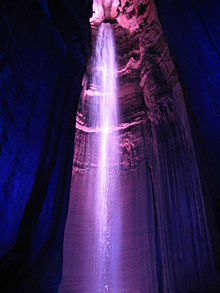
KNOWPIA
WELCOME TO KNOWPIA
Summary
A subterranean waterfall or underground waterfall is a waterfall located underground, usually in a cave or mine.[1] They are a common feature in cave systems where there are vertical or near vertical geological structures for the weathering process to exploit, and sufficient gradient between the sink and the rising.[2][3] Notable examples include Ruby Falls, 44 metres (144 ft) high, in Lookout Mountain Caverns, a show cave in Tennessee[4] and Gaping Gill in the Yorkshire Dales, UK with a fall of 98 metres (322 ft). The highest known subterranean waterfall is in Vrtoglavica Cave in Slovenia, and is at least 400 metres (1,300 ft).[5]


See also edit
References edit
Wikimedia Commons has media related to Subterranean waterfalls.
- ^ "10 Most Incredible Cave Waterfalls on Earth". World Reviewer. Archived from the original on April 23, 2016. Retrieved 4 April 2016.
- ^ Kevin Adams (1 June 2002). Waterfalls of Virginia and West Virginia: A Hiking and Photography Guide. Menasha Ridge Press. p. 32. ISBN 978-0-89732-414-4.
- ^ Waltham, Tony; Murphy, Phil (2013). Waltham, Tony; Lowe, Dave (eds.). Caves and Karst of the Yorkshire Dales. Buxton: British Cave Research Association. p. 136. ISBN 978-0900265-46-4.
- ^ "Tennessee's Spectacular Underground Waterfall". The Weather Channel. 21 March 2014. Retrieved 4 April 2016.
- ^ Pavils, Gatis (7 March 2013). "Vrtiglavica Cave and Waterfall". Wondermondo. Retrieved 4 April 2017.


